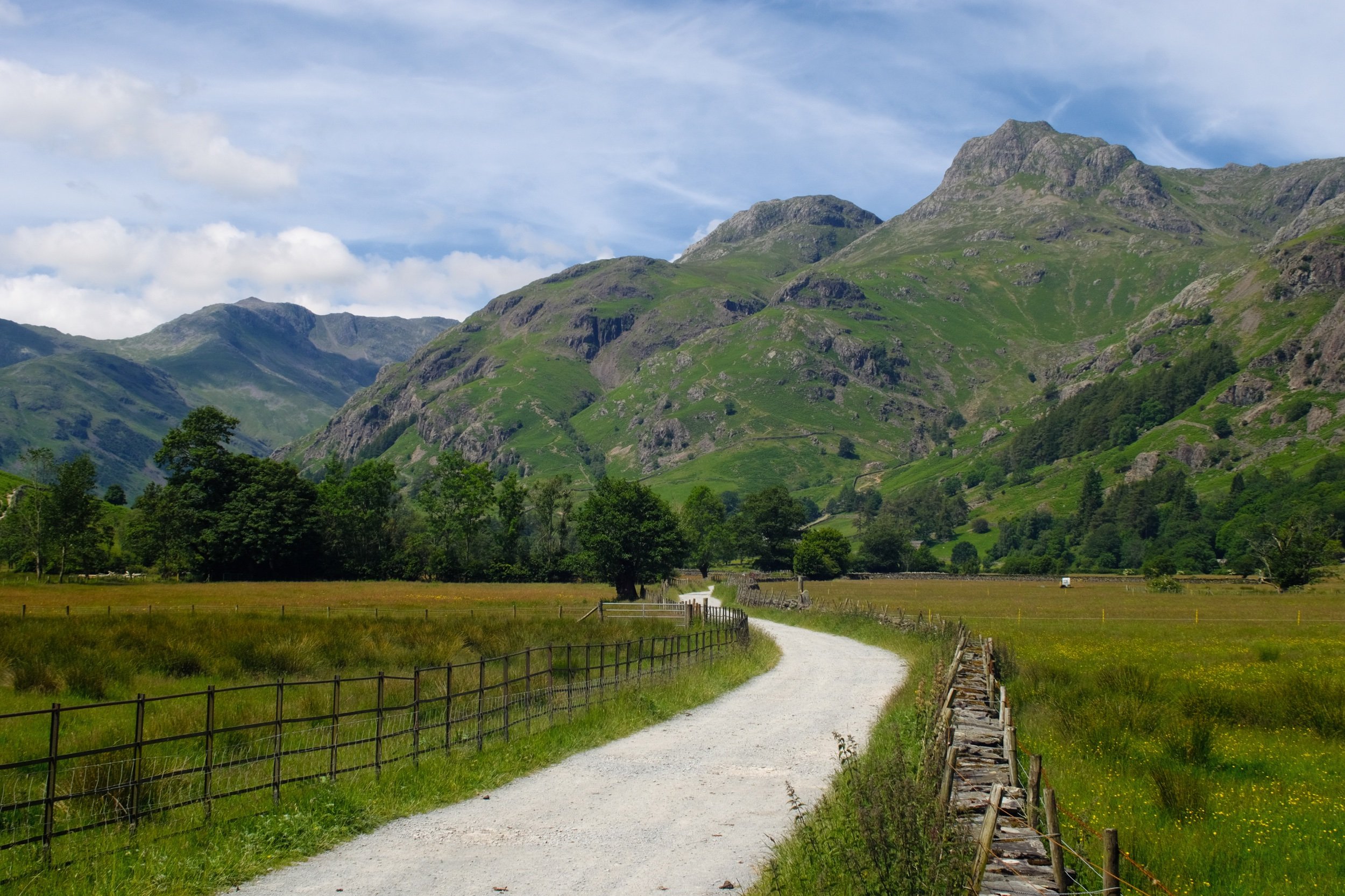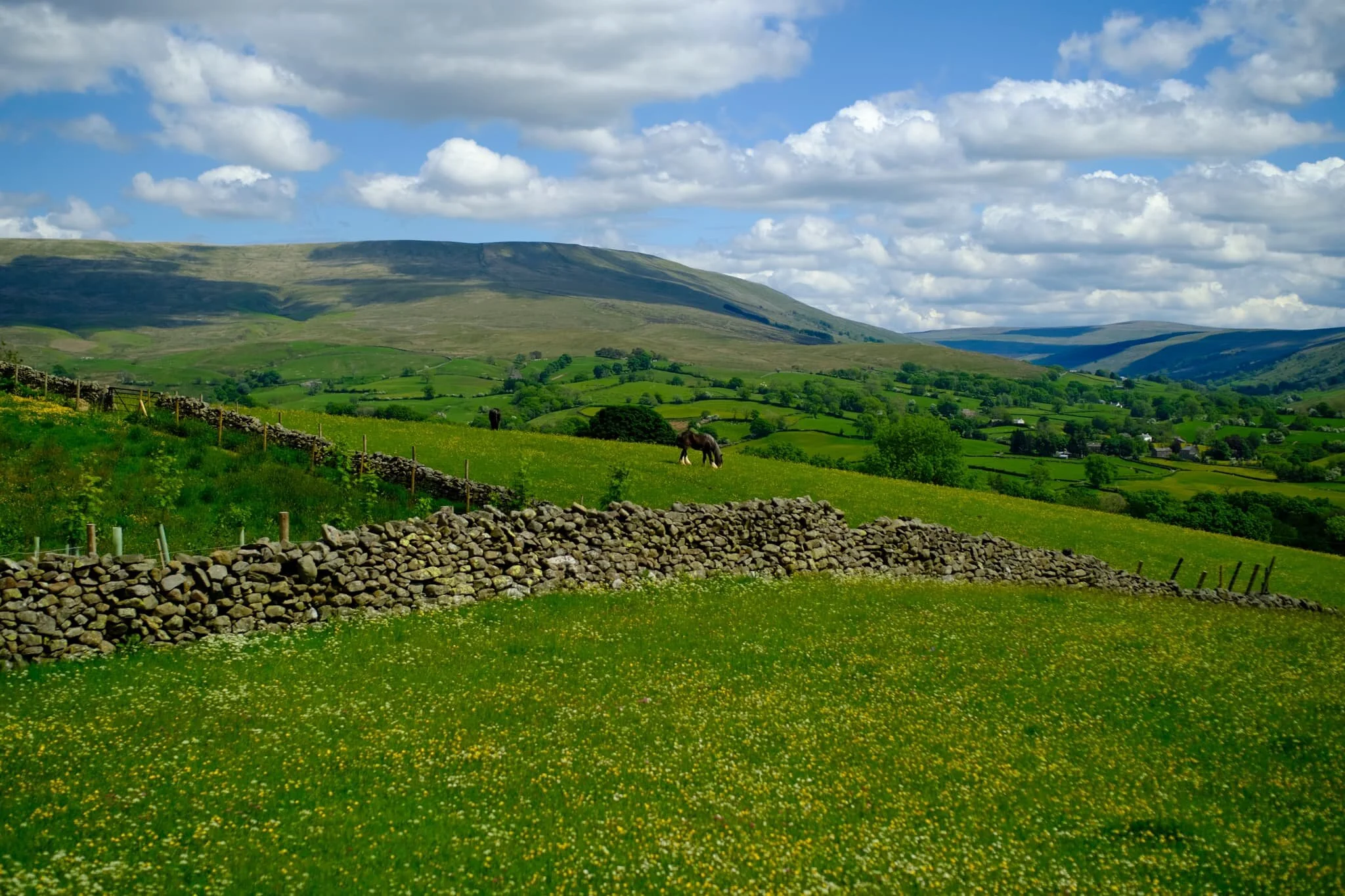Great Langdale, Lake District, Summer
It has been far too long since I’ve been to Great Langdale.
It has been too long since I’ve been to Great Langdale.
In fact, from what I can make out, the last time I visited Great Langdale was November 2020. That’s bad.
And a shame. Great Langdale is one of my favourite places in the whole of the Lake District.
Thankfully I have some time off whilst I transition between jobs, and the UK summer is in full swing. It was time to reacquaint myself with some of the Lake District’s most recognisable peaks.
Great Langdale did not disappoint. My goodness.
All photos shot on my Fujifilm X-T2 using my Vivitar “Series 1” 28–105mm ƒ/2.8–3.8 zoom lens. Images made 90% in-camera using the Velvia film simulation, finished off in Affinity Photo.
I managed to get some parking at the LDNPA’s official car park, right in the heart of the Great Langdale valley. Merely stepping out of the car park offers you scenes like this.
A true Lake District scene: towering craggy fells, stone walls and cottages, green grass, Herdwick sheep.
There were plenty of ewes and their lambs freely milling around the roads and lanes in the valley.
The first leg of the hike I wanted to explore was to head east towards Oak Howe. This part of Great Langdale is heavy with summer meadows and at this time of the year they’re brimming with flowers. Plus, you get panoramas like this.
I threw my lens wide open and got down low to snap the Langdale Pikes high above the fields and fields of buttercups.
Oak Howe cottage, with Oakhowe Crag towering above, itself a subsidiary top of Lingmoor Fell.
One of my favourite spots in Great Langdale, shot near Oak Cowe cottage next to Great Langdale Beck. The Langdale Pikes looking as epic as ever.
For the second leg of the hike, I traced my steps back west, capturing compositions of the Langdale Pikes along the way.
The fist-like crags of the Langdale Pikes to the right, Bowfell to the left.
Whitegill Crag stands protectively over the valley floor and its inhabitants.
Rossett Farm with Thorn Crag and Loft Crag above, like axe heads thrust into the sky.
The western aspect of Great Langdale features its highest fells, accessible via the fell in the middle of this photo known as “The Band”. To the left is Crinkle Crags (859 m/2,818 ft) and to the right is Bowfell (902 m/2,959 ft).
Some kind of rose, I think? I couldn’t tell you which one but it were pretty, just sitting there in the hedgerow.
As I head closer to Stool End Farm, Pike o’ Blisco (705 m/2,313 ft)—south of Crinkle Crags—makes its presence known.
A pied wagtail (Motacilla alba yarrellii) sits atop a drystone wall long enough for me to focus and nab this shot.
A side valley that branches off the main Great Langdale valley, Mickleden, features this great wall of rock known as Rossett Crag, peaking at Rossett Pike (651 m/2,136 ft).
The road to Stool End Farm, which marks the beginning of many popular ascents up to the likes of Bowfell, Crinkle Crags, and beyond.
The western aspect of the Langdale Pikes peaks at Pike o’ Stickle (709 m/2,326 ft), before dropping sharply down to the valley floor.
Heading back east towards the car, this part of the Langdale Pikes is very popular with rock climbers who fancy tackling some tricky climbs.
I love this place.
Did you like these photos?
Sedbergh, Yorkshire Dales, Summer
After Saturday’s hike around Cunswick Fell for some glorious summer scenes, we sought more near the beautiful town of Sedbergh.
After Saturday’s hike around Cunswick Fell for some glorious summer scenes, we sought more near the beautiful town of Sedbergh.
I’ve commented before about the beauty of the Howgills and how Lisabet and I have barely touched them. The comely bumps and folds of these hills will see more of our footsteps in due course. But for this occasion I found a lovely hike that took us up towards the foot of the Howgills, through a couple of farms, and across some incredible wildflower meadows. We then joined the River Rawthey near Buckbank Farm and followed the river all the way back to the town.
A nice 5-mile circular, all in all.
Conditions, light, and scenes could not have been more cooperative for photography. The wildflower meadows beneath the Howgills were glorious.
All photos taken on my Fujifilm X-T2 with my Samyang 35mm f/1.2 lens. Images were made 80% in-camera using a customised Velvia film simulation, with minor edits in Lightroom and Affinity Photo afterwards.
The first of many wildflower meadows above Sedbergh we encountered, with Middleton Fell (609 m/2,000 ft) in the distance.
In the next field a few young bullocks and cows were giving us an inquisitive stare or two. We gingerly navigated around them, giving them plenty of room, but I did manage to fire off one photo.
The views across to Garsdale immediately started to open up. What glorious scenes.
Making our way northeast on the trail towards Ghyll Farm, the fell Crook (461 m/1,513 ft) momentarily darkens under the shade of a passing cloud.
I couldn’t keep my eyes off the sprawling views towards Garsdale. We really do live in a beautiful country.
I spotted this trio of trees with pleasing spacing between them, so I framed up for a composition with Soolbank in the gap.
A field full of buttercups and Knott (429 m/1,407 ft) bulging in the distance. Our destination is the stile over the wall, just to the right of centre.
Just one of many meadows in the foothills of the Howgills, brimming with buttercups. Above, clouds pass over Baugh Fell (678 m/2,224 ft), painting their own shadows onto the hill.
I paused at the top of climbing over the stile to capture this expansive and awe-inspiring view of Baugh Fell and Garsdale, with the characteristic drystone walls of Northern England and a horse grazing for good measure.
Some of the farm houses underneath the Howgills are a good two or three centuries old.
I largely don’t bother with focus stacking anymore. Opened this one all the way to f/1.2, focused on the fell and let the lens do the rest. All the buttercups. This would make a good smartphone wallpaper, actually.
After navigating through Stone Hall Farm we aimed for Buckbank Farm, which would allow us to join the River Rawthey. But not before taking a photo of this frankly ridiculous scene towards two of the southern Howgills, Crook and Knott, with meadows full of buttercups.
Approaching Ellerthwaite Farm, which would lead us to Buckbank and thus the River Rawthey.
Following on from Buckbank Farm we joined the bridleway southwest, which broadly follows the River Rawthey. Our next destination to look out for was Straight Bridge, which we would climb underneath to stay on the bridleway towards Sedbergh.
I always enjoy cows and bulls giving me The Stare…
Cows, trees, the Howgills, and fluffy clouds. A true Northern English summer country scene.
An interesting tree stump provided me with a lovely subject to frame in this composition.
The farm of Scrooge House with its fields of buttercups and the Howgills behind.
After pausing for a spot of packed lunch, we followed the bridleway by the river all the way towards New Bridge.
A rich and vibrant scene of summer colour I spotted by one of the becks that flows into the River Rawthey.
The way back to Sedbergh town. You’ve got to admit, it’s a proper lovely town, isn’t it?
Pandemic Peregrinations: Stainbank Green, Kendal, Cumbria, Spring
Happy 75th Anniversary of VE Day, that is, “Victory In Europe” Day, when the Allies triumphed over the fascist Nazis.
Happy 75th Anniversary of VE Day, that is, “Victory In Europe” Day, when the Allies triumphed over the fascist Nazis. Never forget the sacrifice of those who fought to retain our freedoms and liberties over authoritarian fascists.
It’s a weird time to celebrate VE Day. The UK is still on Lockdown, and so people are still largely staying in their homes, except for Once Per Day Exercise and shopping for essential supplies. So celebrations, if any, are somewhat subdued.
Nevertheless, on our Government Permitted Outdoor Exercise session today, we did spot a few Union Jack flags around and a little bit of bunting.
We took the Brigsteer Road out west of Kendal today, rounded up and through Stainbank Green, and back through Kendal town, stopping briefly for a Socially Distanced takeaway flat white.
In other news
As of 9am on 8th May, 211,364 people in the UK have tested positive for COVID-19 from the Coronavirus. As of 5pm on 7th May, of those tested positive for coronavirus in the UK, 31,241 have sadly died, the highest number of deaths in Europe, and a death rate of 14.78%.
May all those suffering find peace.
And I hope these photos help you to, too.
No British celebration is complete without bunting.
Superb gardening skills going on here.
Kendal has some gorgeous houses.
This is honeysuckle, or Lonicera periclymenum.
A sort of “portal” found in the wooded lanes of Stainbank Green.
Over the stile and out to Stainbank Green.
Google reckons this is Melastoma malabathricum, otherwise known as “Indian rhododendron”.
And Google thinks this is Solanum trilobatum, a herb usually cooked in the Indian subcontinent.
Nether Bridge in Kendal, probably Kendal’s prettiest bridge. Dates from the 17th century.
The view from Nether Bridge is pretty lovely too.
The current parched condition of the River Kent allows wonderful reflections.
The way to a decent flat white.
I can’t remember the last time I had a flat white…
Stramongate Bridge and its weir. Can never resist a shot of this view.
The meadows off the River Kent’s east bank near Mintsfeet has exploded in wild flowers.
A lovely horse enjoying the shade. I mean, it might have been. It was hard to tell, because the horse barely moved and almost seemed catatonic. It accepted nose stroking from Lisabet and I but eventually flinched from me, which alarmed me. So we left it alone and went back the way we came. I hope it’s OK.
My lovely Lisabet enjoying the wild flowers along the river bank.



